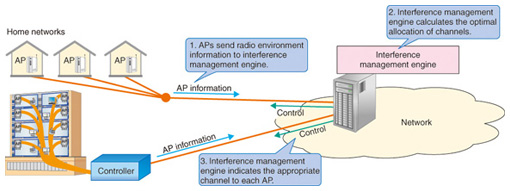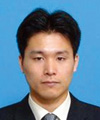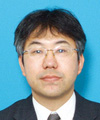 |
|||||||||||
|
|
|||||||||||
|
Feature Articles: Wireless Access Technologies that Enhance Convenience by Network Linkage Vol. 11, No. 3, pp. 14–19, Mar. 2013. https://doi.org/10.53829/ntr201303fa3 High-speed Wireless LAN for Broadband Wireless Home NetworksAbstractThis article introduces cooperative transmission techniques for wireless local area networks (WLANs) to mitigate interference between neighboring wireless home networks by establishing the cooperation of multiple WLAN access points (APs) on the next-generation home ICT (information and communications technology) platform. The cooperative transmission techniques achieve stable transmission of video data (such as for high-definition televisions (TVs)) and data traffic offloading of mobile devices such as smartphones from cellular networks to fixed broadband networks. 1. IntroductionThe number of digital network-capable devices used in homes has rapidly been increasing in recent years due to the digitization of consumer electronics appliances such as televisions (TVs), video recorders, cameras, and music players. Furthermore, new digital devices such as digital photo frames, tablet personal computers (PCs), and smartphones are becoming more and more popular. This trend is expected to increase further in the near future with the introduction of various kinds of sensor terminals. Wireless local area networks (WLANs) can be used to connect these various devices to broadband networks without the need for cables. This convenience has led to the rapid increase in the use of WLANs in homes as well as in offices. However, the rapid growth in the use of smartphones is causing congestion in cellular networks. One solution is traffic offloading to WLANs. Cellular operators are expanding the areas where public WLANs are available by introducing WLAN access points (APs) that are capable of not only 2.4-GHz-band but also 5-GHz-band transmission, and are distributing APs to their users. This article first describes the evolution and challenges of WLAN and then introduces the cooperative transmission techniques that NTT Network Innovation Laboratories is developing for the next-generation WLAN. 2. Evolution and challenges of wireless LANThe first international WLAN standard was introduced in 1997 in Institute of Electrical and Electronics Engineers (IEEE) 802.11, which covered the use of the 2.4-GHz band. This band is called the ISM (industrial, scientific, and medical) band and is used for medical and industrial equipment such as microwave ovens (even those used in the home). In this band, a radio license is not required worldwide if the radio transmission power is less than the regulation value. The 5-GHz band is addressed in new wireless LAN standards IEEE 802.11a and IEEE 802.11n. In the 5-GHz band, no interference occurs from microwave ovens in the home. In the latest WLAN standard, IEEE 802.11n, the channel width for wireless data transmission is 20 or 40 MHz; this means that there are 3 channels or 1 channel in the 2.4-GHz band and 19 or 9 channels in the 5-GHz band. Because the number of installed APs has increased, the number of channels has become insufficient in the 2.4-GHz band. Therefore, the use of the 5-GHz band is increasing. Mobile devices such as smartphones are now being developed that have multi-band capability (5-GHz band and 2.4-GHz band). However, the next generation WLAN standard, IEEE 802.11ac, which targets system throughputs above 1 Gbit/s and uses the 5-GHz band, is currently being drafted by the IEEE 802.11 working group. In IEEE 802.11ac, the channel width will be 80 or 160 MHz in order to achieve higher throughput. For this reason, the number of channels in the 5-GHz band is being reduced to 2 or 4, and consequently, the number of channels in this band is expected to be insufficient in the near future, just as in the 2.4-GHz band. 3. Cooperative transmission techniques for wireless LANTo accommodate the ever-increasing traffic, it is necessary to further improve the frequency utilization efficiency. We are developing cooperative transmission techniques for WLAN to improve frequency utilization efficiency and achieve stable wireless data transmission through the cooperation of multiple APs using the next-generation home ICT (information and communications technology) platform. In this section, we introduce cooperative transmission techniques for WLAN that consist of interference control between home networks, multi-user multi-channel control, and network control. 3.1 Interference control between home networksProblems caused by interference between home networks due to the spread of WLAN is becoming apparent in public areas such as train stations and in dense residential areas such as areas with many apartments, where neighboring APs use the same channel because of the paucity of channels. In the IEEE 802.11ac specifications, as mentioned above, the number of channels will be reduced to 2 or 4 because the channel width is 80 MHz (mandatory) or 160 MHz (optional), which means that interference between home networks is likely to occur in the 5-GHz band in the near future. Given that two APs using the same channel are adjoining, each home network will have only half the average throughput of conventional WLAN because the channel is shared by time division multiple access based on the carrier sense multiple access with collision avoidance (CSMA/CA) protocol (Fig. 1).
We are developing an interference control technique as one solution to the interference problem. This technique links multiple APs by network transmission signals to achieve the cooperation of the APs via the beamforming technology of multi-user multiple-input multiple-output (MU-MIMO) transmission. MU-MIMO, which is a new technology for wireless broadband communication, is expected to be adopted in IEEE 802.11ac as an option (Fig. 2) [1]. It achieves high frequency-utilization efficiency by sending data to multiple stations (STAs) over a single channel at the same time by controlling the directional characteristics of the radio signals by using beamforming control technology so the signals do not interfere with each other. We developed a wireless transmission prototype that employs MU-MIMO transmission, and succeeded in transmitting data in real time to six STAs at more than 1 Gbit/s for the first time in the world (Fig. 3) [2]–[4].
The interference control between home networks is an extension of the beamforming technology of MU-MIMO. An AP sends data to multiple STAs in its home network without letting signals interfere with the neighboring home network by controlling the directional characteristics of the radio signals, so that two APs in each home network can send data to their STAs over the same channel at the same time without interference. As a result, the throughput is approximately double that of the conventional CSMA/CA method (Fig. 4) [5].
3.2 Multi-user multi-channel controlAPs specified in IEEE 802.11ac can perform high-speed communication using the 160-MHz-bandwidth channel as an option. In addition, to ensure compatibility with the conventional IEEE 802.11a and 802.11n protocols, the APs communicate with IEEE 802.11a-specified STAs using 20-MHz-bandwidth channels and with IEEE 802.11n STAs using channels up to the 40-MHz-bandwidth channel. Therefore, when an IEEE 802.11ac-specified AP uses a 20-MHz-bandwidth channel to transmit data to an IEEE 802.11a STA, the frequency utilization efficiency degrades because the 140-MHz band is unused. As one solution, we are developing a multi-user multi-channel control technique in which the AP allocates a communication channel to each STA using 20-MHz-bandwidth units and transmits data to each STA simultaneously by frequency division multiplexing (Fig. 5). This new technique achieves efficient use of frequency resources by transmitting data to each STA using 20-MHz- and 120-MHz-bandwidth channels at the same time. If there is only one active STA in a home network, the AP may use just the 20-MHz-bandwidth channel to communicate with the STA. In this case, by synchronizing the timing of data transmission with the neighboring AP, the AP and the neighboring AP can transmit data via the 20-MHz- and 120-MHz-bandwidth channels at the same time.
3.3 Network control for wireless LANAs mentioned above, the WLAN uses the CSMA/CA method as the medium access control scheme. Because CSMA/CA is based on autonomous distributed control, WLAN users can build a wireless home network simply by using the AP; the channels are selected freely by the users. However, in dense residential areas such as neighborhoods with many apartment buildings, a problem may occur where optimal allocation of channels used by each AP is not performed, and frequency resources are not used effectively. One solution that we are working on is a network control technique for WLAN in which an interference management engine is set on the broadband network. This engine collects information on the radio environment such as channel utilization rates from each AP, calculates the optimal allocation of channels, and informs each AP of the appropriate channel (Fig. 6). This technique enforces optimal channel usage automatically. In addition, techniques to provide a synchronization signal from the Ethernet-based network, called synchronous ethernet (SyncE), and precision time protocol (PTP), have been standardized. These techniques can achieve frequency, phase, and time synchronization between APs, which is expected to make interference control between home networks more accurate by synchronizing the frequency and phase of radio signals transmitted by the APs.
4. ConclusionWLAN is widely used today and has advanced considerably since it first came into use. These networks are continuing to evolve and to achieve higher speed, larger capacity, and greater functionality that will enable them to accommodate various data services in homes, offices, and public areas. References
|
|||||||||||





















